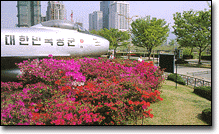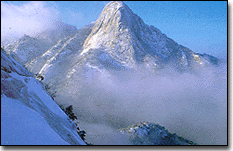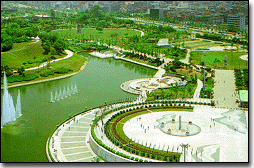
 |




 |
 Namsan Park Namsan Park The Namsan Park is located at Namsan Hill(256m) in the center of Seoul. It contains a variety of cultural and entertainmental facilities, including an octagonal pavilion at the summit, the Seoul Tower, an aquarium, a fountain to the west as well as a botanical garden and a municipal library. Cable cars run to the summit. This is an popular place for citizens in Seoul.
The Namsan Park is located at Namsan Hill(256m) in the center of Seoul. It contains a variety of cultural and entertainmental facilities, including an octagonal pavilion at the summit, the Seoul Tower, an aquarium, a fountain to the west as well as a botanical garden and a municipal library. Cable cars run to the summit. This is an popular place for citizens in Seoul.The park, where the standard triangulation point of Korea is located, has several ways for walk to Namdaemun, Hoehyon-dong, Toikyero 3-ga, Changchung Park, It'aewon and Huam-dong, and good courses to drive. Use of other facilities than cable cars is free of charge. Take Subway Line 1 to Seoul Station, Line 4 to Hoehyon-dong and walk 10 minutes. |
 Poramae Park Poramae Park The contruction of the Poramae Park was launched on December 20, 1985 and opened 395 Shindang-dong, Tongjak-gu, on the site of the former Air Force Academy. on May 5, 1986. Its name, Poramae, came from the symbol of the former air Force Academy. The Park encompasses a lawn, a pond, a swimming pool, a multipurpose stadium, tennis courts and two gyms. Besides, there are many kinds of resting places ad convenieces including a small zoo where deer and birds are bred, Welfare Centr for Elderly and Welfare Center for the Handicapped. Three airplanes on display including a fighter remind visitors of the past times when the Air Force Academy used to be here.
The contruction of the Poramae Park was launched on December 20, 1985 and opened 395 Shindang-dong, Tongjak-gu, on the site of the former Air Force Academy. on May 5, 1986. Its name, Poramae, came from the symbol of the former air Force Academy. The Park encompasses a lawn, a pond, a swimming pool, a multipurpose stadium, tennis courts and two gyms. Besides, there are many kinds of resting places ad convenieces including a small zoo where deer and birds are bred, Welfare Centr for Elderly and Welfare Center for the Handicapped. Three airplanes on display including a fighter remind visitors of the past times when the Air Force Academy used to be here.To get to the park, take Subway Line 2 to Shindaebang Station and Line 1 to Daebang Station and take a city bus. |
 Pukansan National Park Pukansan National Park Designated as a national park in 1983, the Pukansan National Park consists of Mt. Pukansan ad Mt. Tobongsan. Put bith noubtains together, it covers an area of 78.45 sq kilometers. Its southern part includes Seoul's Tobong-gu, Songbuk-gu, Chongno-gu and Unpyong-gu while Kyonggi-do's Koyang City, Yangju-Gun and Uijongbu City form its northeast.
Designated as a national park in 1983, the Pukansan National Park consists of Mt. Pukansan ad Mt. Tobongsan. Put bith noubtains together, it covers an area of 78.45 sq kilometers. Its southern part includes Seoul's Tobong-gu, Songbuk-gu, Chongno-gu and Unpyong-gu while Kyonggi-do's Koyang City, Yangju-Gun and Uijongbu City form its northeast. From old times Mt. Pukansan had several names such as Hansan, Hwasan and Sangaksan. Probably King Sukjong of Choson Dynasty decided to change its name to Pukansan after he built Pukan-sansong(the wall in the mountain). In the national park, there are some cultural remains including Pukan-snasong built in the 37th year of the reign of Sukjong(1711), Toson Temple built by Toson-guksa(national priest) in late Shilla Period, Hwakye Temple built by Shiwol-sonsa underthe reign of Kong Jungjong of Choson Dynasty and Sunggasa��Chinkwansa��Mangwolsa Temples built in Shilla Kingdom. |
 Seoul Grand Park Seoul Grand ParkLocated at the foot of the beautiful Mt. Chonggyesan with an area of 2,840,000 pyong, the Seoul Grand Park is a reating place for citizens in Seoul. With Fresh sunshine, pure air and green water, the park gives dream and hope to children ad energy of life to the parents. The park contains a camping and training ground for students and a site for forest bath as well as a botanical garden and a zoo. In addition, there are the National Modern Gallery and Seoul Land, making the park a good place for all members of family to enjoy together. |
 Yo-ui-do Park Yo-ui-do Park The Yo-ui-do Square covered with black.phphalt for 27 years, was born again as a downtown park with wood, lawn and water. The park was launched on marh 10, 1997, opened partly on October 31,1998 and at last opened entirely to the public in February, 1999.
The Yo-ui-do Square covered with black.phphalt for 27 years, was born again as a downtown park with wood, lawn and water. The park was launched on marh 10, 1997, opened partly on October 31,1998 and at last opened entirely to the public in February, 1999. The park is a green space where people meet the nature in the downtown ad enjoy resting, walking, jogging and many kinds of cultural events. |
 Olympic Park Olympic Park The Olympic Park built in commemoration of 1988 Seoul Olympic Games are divided largely into two parts : One is the sports park with 6 stadiums and the other is Mongchon-tosong(earthen walls) area, the cultural reamains of Paeje Kingdom.
The Olympic Park built in commemoration of 1988 Seoul Olympic Games are divided largely into two parts : One is the sports park with 6 stadiums and the other is Mongchon-tosong(earthen walls) area, the cultural reamains of Paeje Kingdom.The Olympic Park encompasses an outdoor sculpture park, where visitors can walk through the famous sculpture works in the world as well as a resting place such as 88Norimadang and musid fountain. Mongchontosong is Historical Site No.297, known as walls made around 3A.D and located between the Han-gang River to the north and Namhansansong to the south. At the present there is pine woods on the slope side of the walls, making an evergreen view. Main facilities include 6 stadiums for cycling, weght lifting, fencing, gymnastics, swimming and so on, Olympic Center, Olympic Parktel, Monchontosong Historical Center and others. The park is located in Pang-i-dong, Songp'a-gu and admission is free. To get to the park, take Subsay Line 2, get off ar Songnae Station and walk 15 minutes, or take Subway Line 5 and get off at Olympic Park Station. |
 Han-gang Riverside Parks Han-gang Riverside Parks For the purpose of cleaning the Han-gang River, the Han-gang Development Project was launched in September, 1982 and completed in 1986. As a result 41.5 kilometers in total length(between Hail-dong and Taewha-dong) was changed into a clean water with an average width of 175 meters and an average depth of 2.5 meters.
For the purpose of cleaning the Han-gang River, the Han-gang Development Project was launched in September, 1982 and completed in 1986. As a result 41.5 kilometers in total length(between Hail-dong and Taewha-dong) was changed into a clean water with an average width of 175 meters and an average depth of 2.5 meters.Along the Han-gang, there are riverside parks equipped with various sports facilities such as soccer fields, volleyball courts, basketball courts, swimming pools as well as water skiing, yachting, boating and fishing sites ad parking lots. The parks consists of 9 areas : Mangwon, Yo-ui-do, panp'o, chamwon, Cahmshil, Kangnaru and others. The citizens tired of daily routines visit te riverside. Jogging and walking in the morning, lying on the grass and looking up at the sky, the river wind cooling hot summer...... These are ���� difficult to meet in the downtown area surrounded with cars and high-rises. The Han-gang Riverside Parks contribute to making Seoul a pleasant and comfortable city. In Yo-ui-do, Chamshil, Ttuksom areas, ferry terminals are visited by a lot of people. |
|
Copyright ¨Ï 1999 Human Resources Development Service of Korea. All rights reserved. Contact to 36seoul@HRDKorea.or.kr for more information |